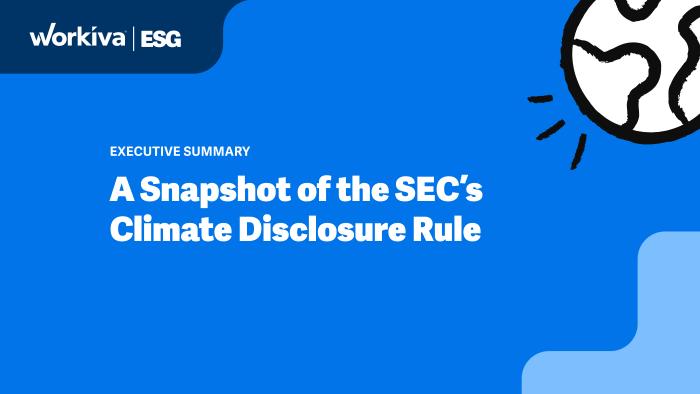CSRD Readiness: Four Critical Next Steps for Midsize Companies

The first phase of the Corporate Sustainability Reporting Directive (CSRD) rollout is just around the corner, which means more than 11,000 public and financial services companies will need to produce an integrated annual report in 2025 with both financial and sustainability data from 2024 and in accordance with the European Sustainability Reporting Standards (ESRS). One year later, the number of companies required to comply with the CSRD will increase significantly, including public and private companies that meet the revenue and employee thresholds from the EU. In short, CSRD readiness is underway in organisations from enterprise to midsize, but many teams and leaders are still figuring out exactly what that means.
For large enterprise organisations that, typically, have dedicated sustainability teams and are approaching the CSRD with many years of ESG disclosures, there are still complex questions about data management and integration across disparate teams. While some may already be undertaking their double materiality and gap assessments, others may be focused on broader data preparation needs.
Many midsize organisations, however, may not have a dedicated sustainability team. If they do, it may be smaller and more recently formed. Likewise, they might have fewer systems in place for sustainability data management, less robust policies and procedures and fewer years of voluntary ESG disclosures. While it’s more likely that they have more agile operational structures, they’re trying to figure out how to tackle the CSRD with fewer resources and in-house experience.
The clock is ticking for CSRD readiness and the challenges are becoming clearer
The head of corporate sustainability at a Dutch company with limited ESG reporting experience shared with Workiva, “I don't have a sustainability team. I'm alone. We’re trying to mobilise everybody to do a little part about it, but people have numerous hats and functions. You have financial managers who need to do ESG reporting—they need to cover social and HR topics. So they're not just doing finance. And it’s difficult to expect further commitment, even from our most dedicated employees.”
It can be argued that midsize organisations are disproportionately affected by the CSRD. A statement released by the European Securities and Market Authority (ESMA) in October 2023 underscores the pressures they feel: “ESMA therefore stresses the importance for issuers that are new to these requirements to put in place adequate planning and resources to ensure that they are able to undergo this dual transition towards both ESRS and compliance with the Taxonomy Regulation…the time and effort needed for an effective and timely transition to the new requirements is still expected to be substantive.”
With a lesser data burden than enterprise organisations, a significant number of smaller companies have been able to pull ahead with their preparations for the CSRD and have already completed their gap and double materiality assessments. But they’re left wondering what to do next.
What should you do following your double materiality and gap assessments?
After overcoming the initial hurdles for CSRD preparation, the leaders at midsize companies that Workiva speaks to frequently share these four key priorities:
- Operationalise the outcome of their double materiality and gap assessments
- Establish how to efficiently collect and interpret 2–3x more sustainability data points
- Determine how to disclose more data in an audit-ready way and that aligns to ESRS’ Application and Disclosure Requirements
- Build seamless channels for collaboration with all individuals involved in the integrated reporting process, including those working within sustainability, finance, risk, corporate communications and investor relations teams
The first point alone is much easier said than done. Some companies with mature, long-standing voluntary ESG reporting programs have found that they’re compliant only with a portion of more than 1,000 ESRS data points across 12 standards and 82 disclosures. Getting up to speed is a significant task that will take time. Whether this is tackled alongside external consultants, or solely with internal resources, the scale of the challenge cannot be underestimated.
Underpinning each of these four points is a need for a coherent and comprehensive strategy that encompasses the need to identify and appoint data owners, determine if data collection should be centralised or decentralised, assess how to use technology to collect data more efficiently, and break down silos between teams.
How Workiva helps midsize companies operationalise and prepare for the CSRD
While technology is not the be-all-and-end-all of solving CSRD challenges, it can certainly help accelerate midsize companies' journey to CSRD compliance.
Workiva provides the only unified platform for finance, sustainability and governance, risk and controls. And it helps you meet CSRD requirements with a purpose-built solution for ESRS disclosures:
- Identify what's required under the ESRS
- Document your double materiality assessment
- Ensure your data collection for material ESRS disclosures is verifiable by an external auditor
- Disclose using pre-built ESRS-aligned disclosure templates
- Collaborate with finance to produce an integrated report, with XBRL® tagging&
Here are practical answers to some of the biggest questions that we receive about CSRD preparation:
How do I document and manage the outcome of my double materiality and gap assessment?
Workiva’s ESG Program helps digitise and manage material topics and sub-topics, from owners to collection dates and even to other voluntary frameworks for consistency.
How do I collect 2–3x more data in an audit-ready way?
Workiva’s pre-built data collection templates, aligned to ESRS, give teams a starting point to efficiently collect auditable data for each material metric.
How do I disclose 2–3x more data in an audit-ready way, aligned to the ESRS’ Application and Disclosure Requirements?
Workiva’s pre-built disclosure templates, aligned to ESRS, help present your data in accordance with Application and Disclosure Requirements while giving you the flexibility to present your data differently and add qualitative narrative.
How do I collaborate with my financial reporting team counterparts to produce an integrated report with XBRL tagging?
Workiva’s cloud-based platform provides a collaborative, controlled environment for finance and sustainability reporting teams to work on a single, integrated document that includes XBRL tagging.
See Workiva for ESG in action—request a demo.
XBRL® is a trademark of XBRL International, Inc. All rights reserved. The XBRL™/® standards are open and freely licensed by way of the XBRL International License Agreement.

